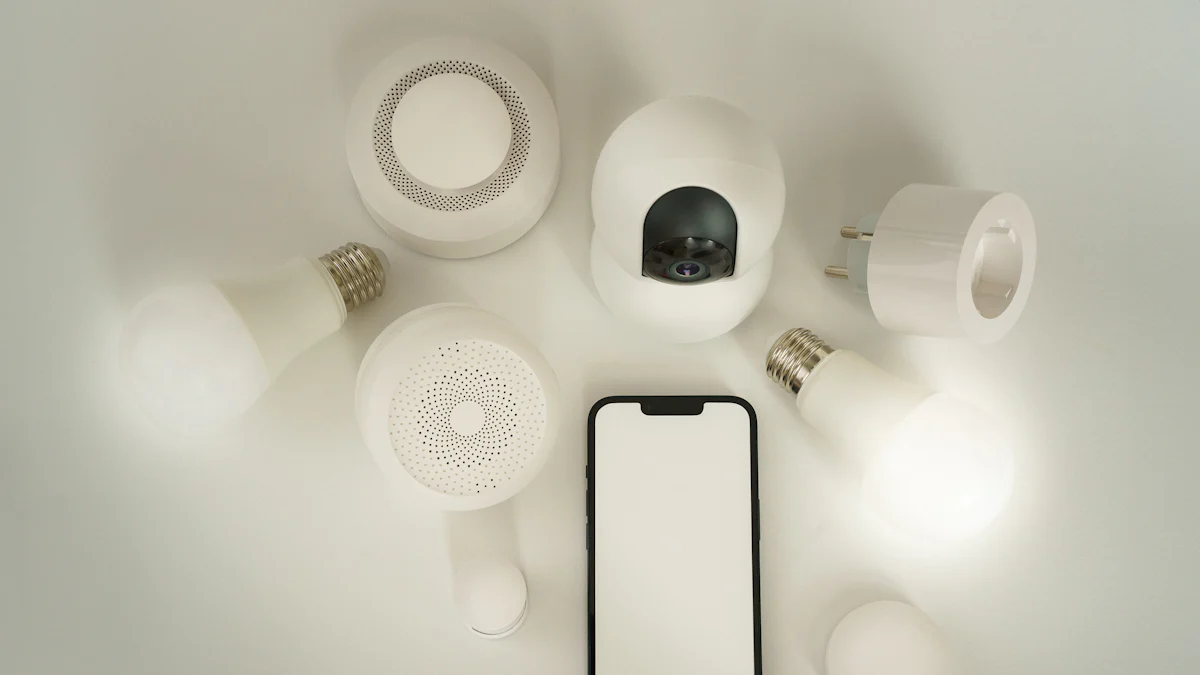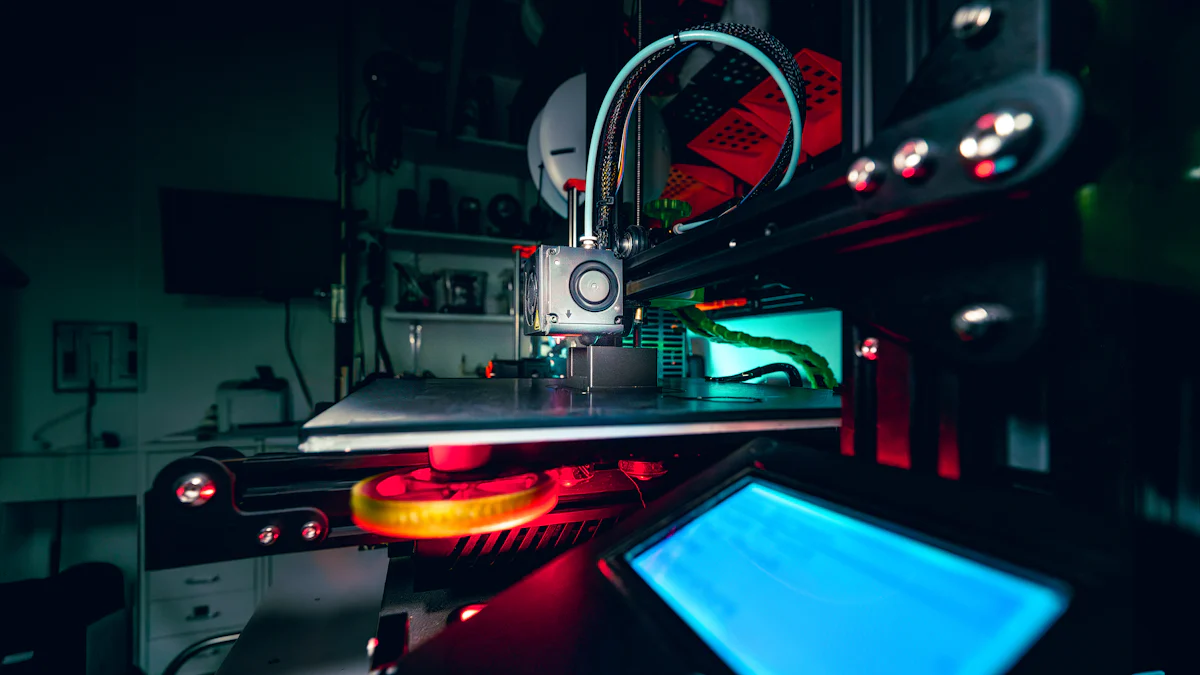How to Integrate the NXP MIMXRT1051CVL5B in Your Smart Home

Imagine transforming your living space into a futuristic haven where technology seamlessly integrates into your daily life. By incorporating the nxpMIMXRT1051cvl5b into your smart home, you can make this vision a reality. With the rapid growth of smart home adoption, more households are embracing the convenience and efficiency these systems offer. In fact, nearly 30% of U.S. internet households now have three or more smart home devices. By integrating this advanced technology, you enhance your home's capabilities and ensure compatibility across various smart home devices. This integration promises a seamless operation, making your smart home experience smoother and more enjoyable.
Understanding the NXP MIMXRT1051CVL5B
Key Features and Benefits
When you dive into the world of smart home technology, the NXP MIMXRT1051CVL5B stands out as a powerful component. This microcontroller offers a range of features that can elevate your smart home experience. First off, it boasts a high-performance ARM Cortex-M7 core, which ensures fast processing speeds. This means your smart home devices can respond quickly to commands, making your interactions smoother and more efficient.
Additionally, the NXP MIMXRT1051CVL5B supports a wide array of connectivity options. This versatility allows you to integrate various smart home devices seamlessly. Whether you're connecting smart lights, thermostats, or security systems, this microcontroller can handle it all. Its robust memory capacity also ensures that your smart home system can store and process large amounts of data without a hitch.
Moreover, the NXP MIMXRT1051CVL5B is designed with energy efficiency in mind. By optimizing power consumption, it helps your smart home devices run longer and more efficiently. This feature not only saves energy but also reduces your electricity bills, making your smart home more sustainable.
Relevance to Smart Home Systems
In the context of smart home systems, the NXP MIMXRT1051CVL5B plays a crucial role. It acts as the brain of your smart home, coordinating the activities of various devices. With its advanced processing capabilities, it can manage complex tasks and automate routines, enhancing the overall functionality of your smart home.
Imagine waking up to a home where the lights gradually brighten, the thermostat adjusts to your preferred temperature, and your coffee maker starts brewing—all without you lifting a finger. The NXP MIMXRT1051CVL5B makes this level of automation possible. By integrating this microcontroller, you can create a smart home environment that anticipates your needs and adapts to your lifestyle.
Furthermore, the NXP MIMXRT1051CVL5B ensures compatibility across different smart home devices. This means you can mix and match products from various brands without worrying about connectivity issues. It provides a unified platform where all your devices can communicate effectively, creating a cohesive smart home ecosystem.
Assessing Your Smart Home Needs
Before diving into the integration process, you need to assess your current smart home setup. This step ensures that you make informed decisions and optimize your smart home experience. Let's explore how you can evaluate your existing system and ensure compatibility with new devices.
Evaluating Current Smart Home Setup
Start by taking a close look at your current smart home setup. Identify the devices you already have and how they interact with each other. Do you have smart lights, thermostats, or security cameras? Make a list of all your smart home gadgets. This inventory helps you understand what you have and what you might need.
Next, consider the performance of your existing devices. Are they meeting your expectations? Do they respond quickly to commands? If you notice any lag or connectivity issues, it might be time to upgrade or replace certain components. A well-functioning smart home should operate smoothly and efficiently.
Think about your daily routine and how your smart home supports it. Are there areas where automation could enhance your lifestyle? For example, if you often forget to turn off the lights, consider adding smart switches or motion sensors. By evaluating your current setup, you can identify opportunities for improvement and expansion.
Ensuring Compatibility with Smart Devices
Once you've assessed your current setup, focus on ensuring compatibility with new smart devices. The NXP MIMXRT1051CVL5B plays a crucial role in this process. It acts as a bridge, allowing different devices to communicate seamlessly within your smart home ecosystem.
Check the specifications of your existing devices and compare them with the requirements of the NXP MIMXRT1051CVL5B. Ensure that your devices support the same connectivity options, such as Wi-Fi or Bluetooth. This compatibility ensures that your smart home devices can work together without any hiccups.
Consider the brands and models of your smart home devices. Some brands offer better compatibility with others. Research and choose devices that are known for their interoperability. This approach minimizes potential conflicts and maximizes the efficiency of your smart home.
Finally, think about future-proofing your smart home. Technology evolves rapidly, and new devices constantly hit the market. Choose devices that can adapt to future updates and advancements. By ensuring compatibility now, you set the stage for a smart home that grows with you.
Step-by-Step Setup Guide

Integrating the NXP MIMXRT1051CVL5B into your smart home can seem daunting, but with a clear step-by-step guide, you can simplify the process. Let's walk through the initial setup, network integration, and performance optimization to ensure your smart home runs smoothly.
Initial Setup and Configuration
Gather Your Tools and Resources: Before you start, make sure you have all necessary tools and resources. This includes the IMXRT1050RM Reference Manual and any user manuals related to your smart home devices. These documents provide valuable insights and troubleshooting tips.
Connect the Microcontroller: Begin by connecting the NXP MIMXRT1051CVL5B to your smart home hub or central system. Ensure all connections are secure to avoid any interruptions in communication between devices.
Power Up and Test: Once connected, power up the microcontroller. Test its basic functions to confirm it's operating correctly. This step ensures that your smart home devices will respond as expected.
Access Configuration Settings: Use the user manual to navigate through the configuration settings. Adjust these settings to match your smart home needs. This might include setting up device names, assigning roles, or configuring initial automation routines.
Network Integration and Customization
Connect to Your Network: Integrate the microcontroller into your home network. Ensure it connects to your Wi-Fi or Ethernet, depending on your setup. A stable network connection is crucial for seamless smart home operation.
Customize Device Settings: Customize each smart home device connected to the microcontroller. This could involve setting specific schedules for lights or adjusting thermostat settings. Tailor these settings to fit your lifestyle and preferences.
Test Connectivity: After customization, test the connectivity between devices. Make sure they communicate effectively with each other and the central hub. This step helps identify any potential issues early on.
Optimizing Performance for Smart Home Devices
Monitor Device Performance: Regularly monitor the performance of your smart home devices. Check for any delays or malfunctions. Address these issues promptly to maintain optimal performance.
Update Firmware and Software: Keep the firmware and software of your smart home devices up to date. Updates often include performance improvements and security patches, enhancing the overall functionality of your system.
Adjust Power Settings: Optimize power settings to ensure energy efficiency. The NXP MIMXRT1051CVL5B is designed with energy efficiency in mind, so take advantage of this feature to reduce energy consumption and costs.
By following these steps, you can successfully integrate the NXP MIMXRT1051CVL5B into your smart home. This integration not only enhances your home's capabilities but also ensures a seamless and efficient smart home experience.
Creating Synergy Through Automation

In the world of smart homes, automation is the magic that brings everything together. By linking your devices, you can create a seamless experience that enhances your daily life. Imagine your Lumary Smart RGBAI Landscape Lights automatically adjusting their brightness based on the time of day or your Lumary Smart Curtain Lights opening to let in the morning sun. This level of integration transforms your home into a responsive environment that caters to your needs.
Linking Devices for Advanced Functionality
To achieve advanced functionality, you need to link your devices effectively. Start by identifying which devices can work together. For instance, your Lumary Smart LED Outdoor lights can sync with your Lumary Smart RGBAI Recessed Light to create a cohesive lighting scheme. This not only enhances the aesthetic appeal of your home but also improves energy efficiency.
Consider using a central hub or app to manage your devices. This allows you to control everything from one place, making it easier to set up routines and schedules. For example, you can program your Lumary Smart Outdoor Neon lights to turn on at sunset and off at sunrise. This kind of automation not only saves energy but also adds a layer of security to your home.
Case Study: Mr. and Mrs. White's Smart Home Transformation
Enhanced Functionality: By integrating their Lumary Smart RGBAI devices, they created a dynamic lighting system that adjusted to their lifestyle.
Security Boost: Their Lumary Smart Outdoor Lights provided added security by illuminating dark areas around their home.
Entertainment Upgrade: The Lumary Smart RGBAI Landscape Lights Pro enhanced their outdoor gatherings with vibrant colors and patterns.
Automating Routine Tasks with Smart High Bay Lights
Smart High Bay Lights offer a unique opportunity to automate routine tasks in your home. These lights are perfect for large spaces like garages or basements, where manual control can be cumbersome. By integrating them with your smart home system, you can automate their operation based on your schedule or activity.
For instance, you can set your Smart High Bay Lights to turn on when you enter the garage and off when you leave. This not only provides convenience but also ensures that you never leave the lights on by accident. Additionally, you can link them with other devices, such as your Lumary Smart RGBAI Recessed Light, to create a unified lighting experience throughout your home.
Automation doesn't stop at lighting. Consider integrating your Lumary Smart Bird Feeder with your smart home system. You can set it to dispense food at specific times, ensuring your feathered friends are always well-fed. This level of automation simplifies your life and allows you to focus on what truly matters.
By creating synergy through automation, you unlock the full potential of your smart home. Your Lumary devices work together to provide a seamless experience that enhances convenience, security, and energy efficiency. Embrace the power of automation and transform your home into a smart haven.
Ensuring Security in Your Smart Home
In today's interconnected world, securing your smart home is more important than ever. With the rise of smart devices, you must take proactive steps to protect your network and personal data. Let's explore how you can safeguard your smart home environment.
Protecting Your Smart Home Network
Your smart home network serves as the backbone for all your connected devices. To keep it secure, start by setting up a strong, unique password for your Wi-Fi network. Avoid using easily guessable passwords like "123456" or "password." Instead, create a complex password with a mix of letters, numbers, and symbols.
Next, consider enabling network encryption. Most modern routers offer WPA3 encryption, which provides robust security for your smart home network. Check your router's settings and ensure this feature is activated.
Regularly updating your router's firmware is crucial. Manufacturers often release updates to patch security vulnerabilities. By keeping your router up to date, you reduce the risk of cyberattacks on your smart home network.
Scientific Research Findings:
A study by CE Pro highlights that manufacturers and vendors are expected to enhance cybersecurity practices to maintain customer trust. Regular updates play a key role in this process.
Additionally, consider setting up a guest network for visitors. This separate network allows guests to connect to the internet without accessing your main smart home devices. It adds an extra layer of security by isolating your smart devices from potential threats.
Safeguarding Personal Data
Your smart home devices collect and store a wealth of personal data. Protecting this information is essential to maintaining your privacy. Start by reviewing the privacy settings on each of your smart devices. Many devices offer options to limit data collection or disable certain features. Adjust these settings to align with your comfort level.
Be cautious about the apps you install on your smartphone or tablet. Only download apps from reputable sources, and read reviews to ensure they are trustworthy. Some apps may request unnecessary permissions, so always review what access they require before installation.
Scientific Research Findings:
According to a study by NIST, users of smart home technology may lack understanding of privacy and security implications. Manufacturers often fail to provide transparency, making it crucial for you to take control of your data privacy.
Consider using a virtual private network (VPN) when accessing your smart home devices remotely. A VPN encrypts your internet connection, making it more difficult for hackers to intercept your data. This added layer of security ensures your personal information remains private.
Finally, regularly monitor your smart home devices for unusual activity. Many devices offer alerts or notifications for suspicious behavior. By staying vigilant, you can quickly identify and address potential security threats.
By taking these steps, you can create a secure smart home environment that protects both your network and personal data. Embrace these practices to enjoy the convenience of smart technology without compromising your privacy.
Maintenance and Troubleshooting
Keeping your smart home running smoothly requires regular maintenance and a proactive approach to troubleshooting. Let's dive into some practical tips and solutions to ensure your smart devices, like lights and other home gadgets, perform at their best.
Regular Maintenance Tips
Routine Checks: Regularly inspect your smart devices for any signs of wear or damage. Pay special attention to your smart lights and other frequently used gadgets. This helps you catch potential issues early.
Firmware Updates: Keep your devices up to date. Manufacturers often release firmware updates that improve performance and security. Check for updates monthly to ensure your smart home stays current.
Clean Devices: Dust and debris can affect the performance of your smart devices. Gently clean your smart lights and other gadgets with a soft cloth to maintain their efficiency.
Network Health: Monitor your Wi-Fi network's performance. A strong and stable connection is crucial for seamless smart home operation. Consider upgrading your router if you experience frequent connectivity issues.
Battery Check: For battery-operated devices, regularly check and replace batteries as needed. This ensures your smart home devices remain operational without interruptions.
Common Issues and Solutions
Connectivity Problems: If your smart lights or other devices lose connection, start by rebooting your router. This simple step often resolves minor connectivity issues. If problems persist, check for interference from other electronic devices.
Device Unresponsiveness: When a smart device doesn't respond, try resetting it. Refer to the user manual for specific reset instructions. This often restores functionality and resolves minor glitches.
App Malfunctions: If your smart home app crashes or behaves erratically, update it to the latest version. Developers frequently release updates to fix bugs and enhance performance.
Automation Failures: If your automation routines don't work as expected, review the settings in your smart home app. Ensure all devices are properly linked and configured. Sometimes, reprogramming the routine can resolve the issue.
Security Concerns: Regularly review the security settings of your smart home devices. Enable two-factor authentication where possible to add an extra layer of protection. This helps safeguard your personal data and home network.
"Understanding the candidate's troubleshooting approach in smart room automation systems is crucial to assess their problem-solving mindset and reliability in ensuring system performance." - Smart Room Automation Specialist Candidate
By following these maintenance tips and troubleshooting solutions, you can keep your smart home running efficiently. Regular attention to your devices ensures they continue to enhance your home life, providing convenience and peace of mind.
You've now explored how to integrate the NXP MIMXRT1051CVL5B into your Smart Home, enhancing its capabilities and ensuring seamless operation. This integration process not only boosts the efficiency of your Smart devices but also opens doors to further customization and enhancements. Imagine walking into a room and having the Lights automatically adjust to your presence, or using voice commands to control your appliances. These Smart features make daily tasks more manageable and your home more responsive to your needs. As you continue your Smart Home journey, remember to maintain security and keep your system updated for an efficient and safe environment.
See Also
Create Your Own Raspberry Pi Thermal Camera Easily
Integrate FPV Thermal Cameras for Improved Drone Vision
Boost Drone Imaging with Analog FPV Thermal Cameras
Contact Us: Ms. Coco Huang
E-mail: sales@iasun.cn
WhatsApp/Wechat: +86 13510421923

